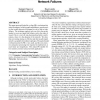Free Online Productivity Tools
i2Speak
i2Symbol
i2OCR
iTex2Img
iWeb2Print
iWeb2Shot
i2Type
iPdf2Split
iPdf2Merge
i2Bopomofo
i2Arabic
i2Style
i2Image
i2PDF
iLatex2Rtf
Sci2ools
103
Voted
HOTNETS
2010
2010
Packet re-cycling: eliminating packet losses due to network failures
This paper presents Packet Re-cycling (PR), a technique that takes advantage of cellular graph embeddings to reroute packets that would otherwise be dropped in case of link or node failures. The technique employs only one bit in the packet header to cover any single link failures, and in the order of log2(d) bits to cover all non-disconnecting failure combinations, where d is the diameter of the network. We show that our routing strategy is effective and that its path length stretch is acceptable for realistic topologies. The packet header overhead incurred by PR is very small, and the extra memory and packet processing time required to implement it at each router are insignificant. This makes PR suitable for loss-sensitive, mission-critical network applications. Categories and Subject Descriptors C.2.2 [Computer-Communication Networks]: Network Protocols--Routing protocols; C.2.6 [Computer-Communication Networks]: Internetworking General Terms Algorithms, Design, Reliability Keywords...
Cellular Graph Embeddings | Computer Networks | Computer-Communication Networks | HOTNETS 2010 | Packet Header |
Related Content
| Added | 17 May 2011 |
| Updated | 17 May 2011 |
| Type | Journal |
| Year | 2010 |
| Where | HOTNETS |
| Authors | Suksant Sae Lor, Raul Landa, Miguel Rio |
Comments (0)

